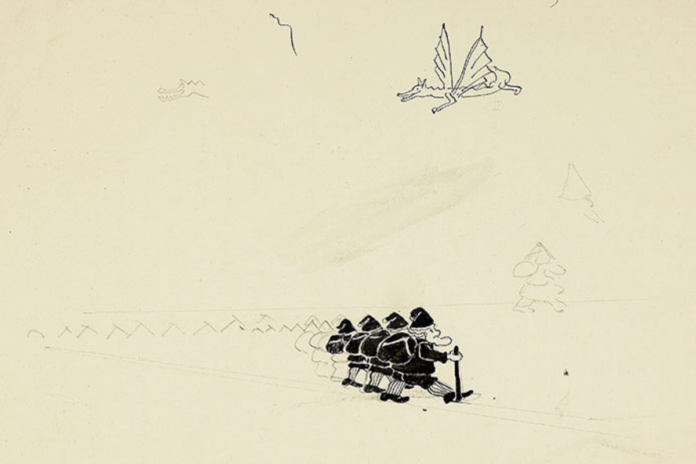Essentially, Hobbit mirrors Zenith, and Bilbo embodies the role of Babbitt within a world imbued with magic and marvels.
Tolkien’s classic drew inspiration from a novelist who later won the Nobel Prize.
Tolkien’s Creative Process And The Hobbit’s Genesis
J.R.R. Tolkien frequently experienced flashes of creative inspiration unexpectedly, often while absorbed in philological studies or fulfilling his roles as a university educator. This pattern also held true for the inception of The Hobbit.
In 1930, Tolkien found himself marking secondary school exam papers to supplement his income while working as a prestigious Anglo-Saxon professor at Oxford University. Despite his esteemed position, he faced financial pressure with four children to support and educate. While marking, Tolkien often doodled on the exam scripts to alleviate the monotony. During one such moment of distraction or boredom, he penned the famous sentence that has since been widely quoted. In a moment of distraction or boredom, then, he wrote the following much-quoted sentence on a spare page of examination paper:
In a hole in the ground there lived a hobbit.
Also Read: Palestine In Israeli Schoolbooks
The Hobbit: A Reinterpretation Of England As An Untamed Frontier
In “The Hobbit,” Tolkien presents a fresh perspective on England, envisioning it as a Western realm bordering a vast and mysterious continent. Bilbo Baggins, the protagonist, known for his love of home comforts, frequently reminisces about his cozy English life during his journey through the treacherous Misty Mountains.
This nostalgic reflection serves as his benchmark for evaluating the unfolding events on his adventurous quest. Essentially, “The Hobbit” follows the timeless narrative archetype of a courageous voyager departing from the safety of home to explore the wide expanse of the world beyond.
At first glance, it may seem unexpected that J.R.R. Tolkien acknowledged a potential influence on “The Hobbit” from Sinclair Lewis’s contemporary American novel, “Babbitt” (1922), which shares a similar-sounding name. Tolkien noted that “Babbitt” possessed a comparable sense of bourgeois complacency to hobbits. Both works depict a world characterized by narrow-mindedness and limited perspectives.
The Influence And Evolution Of Literary Terms: From “Babbitt” To “Hobbitry”
Coincidentally, similar to the later phenomenon with the word “hobbit,” the term “babbitt” – denoting a narrow-minded, self-satisfied individual – quickly gained traction in popular language after its publication. Both terms remain included in the Concise Oxford Dictionary. Literary historian James M. Hutchisson demonstrated the widespread and creative usage of “babbitt.”
Sinclair Lewis himself referenced being immersed in “Babbitt” fervently. British sociologist C.E.M. Joad authored a study titled “The Babbitt Warren,” delving into American society in 1926. Additionally, American writer H.L. Mencken contributed to the term’s popularity by utilizing “Babbittry.” Tolkien also adopted this linguistic trend, employing “hobbitry” in his letters to critically discuss whether sections of “The Lord of the Rings” focusing on hobbits and the Shire might detract from the central narrative of the War of the Ring.
Tolkien’s Unexpected Interest In “Babbitt”
It’s understandable to feel surprised by Tolkien’s interest in “Babbitt,” and Hobbit as the storyline would seemingly be disconnected from his own interests. In Sinclair Lewis’s novel, the protagonist, George F. Babbitt, is a businessman residing in the mid-sized American city of Zenith, depicted through an ironic lens in the opening sentence as a place dominated by imposing steel, cement, and limestone towers.
This setting starkly contrasts with Tolkien’s signature opening descriptions, highlighting the divergence in themes and settings between the two authors’ works.
In a hole nestled within the earth resided a hobbit. This was no unpleasant, grimy, damp den infested with worms and foul odors, nor was it a parched, empty, sandy hollow lacking in amenities for rest or sustenance. Rather, it was a hobbit’s abode, synonymous with warmth and coziness.
The Unexpected Appeal Of “Babbitt” to Tolkien: A Departure From Literary Expectations
The surprise surrounding Tolkien’s interest in “Babbitt” stems from the novel’s nature as the quintessential American “great realist novel,” intended as a satirical commentary on the conventionalities of Midwestern urban society. This realist approach, grounded in meticulous sociological research, is evident in the narrative’s detailed portrayal of everyday activities such as waking, washing, and dressing. This style of literature, reminiscent of the “great realist novel,” may not align with the preferences of a former member of the TCBS, Tolkien’s literary circle from his school days in Birmingham.
The TCBS, or “Tea Club, Barrovian Society,” gathered like-minded school friends who bonded over their shared literary interests, organizing clandestine tea parties and engaging in discussions about their literary works. While the TCBS foreshadowed the more renowned Inklings literary circle, of which Tolkien was a prominent figure during his tenure as a professor of English philology at Oxford University, the departure from their purist literary ideals makes Tolkien’s interest in “Babbitt” particularly unexpected.
Folk-Tale Elements And Irony In Sinclair Lewis’s “Babbitt”
In the opening scene of Sinclair Lewis’s novel “Babbitt,” two folk-tale elements are employed ironically. One such element is the reference to “giants” in the depiction of the factory whistles echoing across the cityscape.
The factory whistles sounded a cheerful greeting, their chorus resonating as brightly as the dawn in April. This was the song of labor in a city that appeared to be constructed for beings of immense stature.
The protagonist, labeled as “unromantic,” stands as an anti-hero in Sinclair Lewis’s narrative, where the author emphasizes that the man awakening in a Dutch Colonial house in Floral Heights possesses no hint of grandeur. This portrayal sharply contrasts with Tolkien’s fascination with the Anglo-Saxon concept of “lead enta generic” (the ancient work of giants). Additionally, the mention of a “fairy child” arises solely within the framework of a recurring dream experienced by Babbitt each morning amidst the noises of the morning milk truck and the slamming of the basement door.
He appeared affluent, firmly committed to his marriage, and devoid of any romantic inclinations. The sleeping porch itself exuded a lack of romance, offering views of a single substantial elm tree, two well-maintained grassy areas, a concrete driveway, and a utilitarian corrugated iron garage. However, despite this setting, Babbitt found himself once more immersed in a dream featuring the fairy child, a vision more romantically captivating than scarlet pagodas beside a shimmering sea.
The Persistent Presence Of The Fairy Child
For years, the fairy child had visited him. While others merely perceived Georgie Hobbit Babbitt, she perceived a valiant young man. She awaited him in the obscurity of enigmatic forests. He hurried to her side whenever he could break free from the bustling household.
Despite attempts by his wife and demanding friends to accompany him, he managed to elude them, with the girl swiftly by his side, and they nestled together on a dimly lit hillside. She possessed a delicate, ethereal appearance, radiating eagerness.
While there are few parallels with Tolkien’s work in this passage, one concept that stands out is the theme of escape, which recurs throughout this page and the following. Indeed, escape serves as the central theme of Sinclair Lewis’s novel, portraying a conventional man’s futile endeavor to break free from the constraints of his narrow life.
His journey involves shedding unquestioning adherence to rigid values, leading him from domesticity to an extramarital affair and from safe conservatism to a fleeting dalliance with radical socialism.
Thematic Affinities And Stylistic Parallels Between Tolkien And Sinclair Lewis
Both Tolkien and Sinclair Lewis demonstrate thematic affinities, despite their distinct methods and perspectives. In his contemporary lecture “On Fairy-stories,” Tolkien identifies escape, recovery, and consolation as key elements of fairy stories, with escape serving as a form of protest against the restrictive mechanistic norms of modern society.
This thematic alignment illustrates a connection between Tolkien and a modern realist writer, such as Sinclair Lewis, despite their differing approaches. Furthermore, both authors exhibit a comedic style in their writing.
An ironic passage concerning Bilbo Baggins’s conventionality highlights this similarity, suggesting that if “Baggins” were substituted with “Babbitt” Hobbit and “The Hill” with “Floral Heights,” the extract would seamlessly fit into Sinclair Lewis’s novel.
For generations, the Baggins family had resided near The Hill, garnering respect from the community. Their respectability stemmed not only from their wealth but also from their predictable and uneventful lives. A Baggins could always be counted on to respond predictably to any situation without the need for inquiry. However, this tale recounts the extraordinary journey of Baggins, who embarks on an adventure, finding himself engaging in unexpected actions and utterances.
Transformation And Self-Discovery: Journeys Of Babbitt And Bilbo
Babbitt and Bilbo undergo transformative adventures in contrasting social spheres, chronicling their respective journeys and returns. By the novel’s conclusion, Babbitt exhibits increased self-awareness. He demonstrates unexpected liberalism in response to his son’s elopement, a freedom he himself struggles to attain.
While Babbitt may outwardly maintain conformity, internally he undergoes significant change. Similarly, Bilbo experiences a shift in perception upon his return from abroad, losing his previous reputation in the community. This sense of growth and wisdom acquired through numerous experiences underscores the parallel themes of transformation evident in both narratives.
Also Read: S*^! And Shoah: The New Jew In Film


